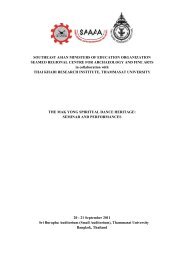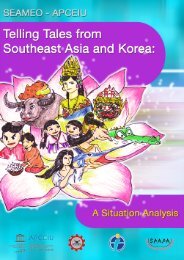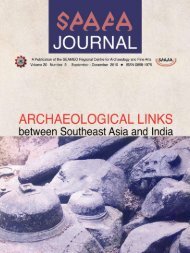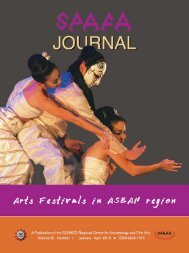Perspectives on Heritage Tourism - Seameo-SPAFA
Perspectives on Heritage Tourism - Seameo-SPAFA
Perspectives on Heritage Tourism - Seameo-SPAFA
You also want an ePaper? Increase the reach of your titles
YUMPU automatically turns print PDFs into web optimized ePapers that Google loves.
<str<strong>on</strong>g>Perspectives</str<strong>on</strong>g> <strong>on</strong> <strong>Heritage</strong> <strong>Tourism</strong><br />
<str<strong>on</strong>g>Perspectives</str<strong>on</strong>g> <strong>on</strong> <strong>Heritage</strong> <strong>Tourism</strong><br />
tains, forests, rivers and dams. Large segments of Purulia’s populati<strong>on</strong><br />
are members of indigenous communities, each of which has a<br />
unique identity that is rich in folk art and crafts, oral traditi<strong>on</strong>s, and<br />
performing arts.<br />
In this paper, we share the story of building partnerships to promote<br />
community-led cultural heritage tourism in Purulia. Our organisati<strong>on</strong>,<br />
banglanatak dot com, with its headquarters in Kolkata, India,<br />
is a social enterprise driven by the goal of improving the quality of<br />
life of poor and marginalised communities. We work to develop<br />
creative industries based <strong>on</strong> indigenous art and culture, such as the<br />
Folk Art Business Hubs, which offer cultural products and services<br />
based <strong>on</strong> local cultural, traditi<strong>on</strong>al, and natural resources. Owned<br />
and managed by groups of folk artists, the Folk Art Business Hubs<br />
promote cultural heritage tourism in the tribal district of Purulia.<br />
This paper tells the story of our journey: the capacity-building<br />
activities that encouraged local folk artists to become cultural<br />
entrepreneurs, and the partnerships we developed with a wide<br />
cross-secti<strong>on</strong> of stakeholders. The paper also narrates how the<br />
host communities benefitted from ec<strong>on</strong>omic development,<br />
c<strong>on</strong>servati<strong>on</strong> of their art, culture, and natural envir<strong>on</strong>ment, and how<br />
this led to upholding their rights and identities.<br />
Rati<strong>on</strong>ale of the project<br />
Purulia is the poorest district in West Bengal, and more than 18<br />
percent of its populati<strong>on</strong> is composed of tribal peoples (census, 2001).<br />
The rural populati<strong>on</strong> practises subsistence farming, and agricultural<br />
productivity is very low. They are thus either heavily dependent <strong>on</strong><br />
n<strong>on</strong>-agricultural income-generati<strong>on</strong> activities, mostly working as<br />
daily labourers or are dependent <strong>on</strong> local forest resources for<br />
livelihood. Owing to the lack of ec<strong>on</strong>omic opportunities, the<br />
most comm<strong>on</strong> livelihood is ‘bidi’ (tobacco leaf) binding, which is<br />
extremely hazardous to health, and makes tuberculosis a very<br />
comm<strong>on</strong> disease in this regi<strong>on</strong>.<br />
The Purulia district is part of the Chot<strong>on</strong>agpur plateau area which<br />
is home to a number of tribal communities. S<strong>on</strong>gs and dance are<br />
intrinsic parts of local community festivals and rituals, such as<br />
marriage cerem<strong>on</strong>ies, sowing and reaping of grains, etc.. Jhumur<br />
s<strong>on</strong>gs and dance are part of such occasi<strong>on</strong>s wherein the entire<br />
community participates. Village women and girls sing and dance,<br />
usually with arms entwined, to the beat of dhol, dhamsa, madal<br />
(various types of drums) and kartal (cymbals) played by the village<br />
men. The art forms are popular am<strong>on</strong>g rural agrarian and artisan<br />
communities like Kurmi, Kumhaar, Rajwar, Ghatoal, Mal Mahali,<br />
Bhumij, Hari, Muchi, Dom, Kamar, and Bagdi, and tribal peoples like<br />
the Santhal, Munda, Orao, Ho, Kharia, and Birhor tribes living in<br />
the Chot<strong>on</strong>agpur regi<strong>on</strong>. Chhau dance is performed by the tribal<br />
communities of the Santhals, Kumars, Mahatos, Kalindis, and<br />
Sahishes. It is a vigorous form of masked dance, using elaborate<br />
masks, colourful costumes, rhythmic drum beatings, and powerful<br />
acrobatic movements and somersaults in the air. The masks are<br />
made by skilled craftsmen living in villages, such as Charida and<br />
Joypur. Lac (shellac), a key product of this area, is used by artisans<br />
to make beautiful craft and jewellery. Tassar silk, woven in handlooms,<br />
is another traditi<strong>on</strong>al product. More than a decade ago,<br />
buyers used to come from the Gulf states to buy Tassar.<br />
However, political disturbances in the Middle East, competiti<strong>on</strong><br />
with power loom, and increased competiti<strong>on</strong> from imports, have<br />
led to a dying hand-spun silk industry.<br />
38<br />
39










